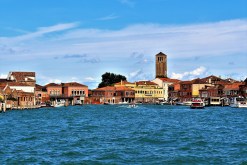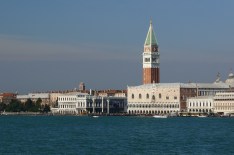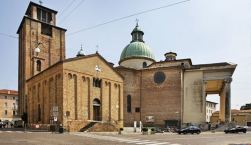Michelangelo is a proud official supplier of Arena tickets.
Set against the magnificent backdrop of Verona’s ancient amphitheater, each performance transforms into a truly unforgettable musical journey. An evening at the Arena is a highlight not only for opera enthusiasts but for anyone seeking a remarkable experience. Celebrate the 100th edition of the Arena di Verona Opera Festival and explore the many attractions in Veneto as well as various Group Tours to Italy.
Michelangelo employees experience a night at the Arena di Verona Opera Festival
What to Do and Where to Go in Veneto
Padova
Basilica di Sant’Antonio
This grand basilica, adorned with multiple domes, is the centerpiece of Padua’s historic old town. Completed in the 1200s, it features a blend of architectural styles and is recognized as one of the international shrines of the Holy See. Its main entrance is framed by intricately designed archways, while eight domes rise majestically above the structure, accompanied by charming towers. Inside, you’ll find frescoes and vibrant artwork that embellish nearly every inch of the basilica, along with exquisite gold accents and marble sculptures. Numerous chapels showcase remarkable Renaissance pieces from renowned artists such as De Zevio.
Orto Botanico
This enchanting botanical garden is home to a diverse array of plants, herbs, and trees. One of the oldest gardens still in operation, it was originally created as a learning space for university students. It features modern greenhouses filled with various plant species at one end, while the other end boasts a traditionally arranged nursery garden with charming circular sections. If you have a passion for flora and nature, the Orto Botanico is sure to delight you.
Brenta Canal
The Brenta Canal stretches for miles, from Chioggia on the coast all the way to Padua, where it reconnects with the Brenta River. Originally constructed to enhance trade routes for Venice and other major cities in Northern Italy, boat tours are available along this picturesque waterway, offering views from Padua to Venice and back. Along the route, you’ll encounter charming villas, stately homes, and landmarks like Villa Foscari and Villa Pisani, with stunning natural scenery providing a delightful backdrop.



Venice
Lagoon Ride
A boat trip around the Venetian lagoon typically includes three key islands: Murano, Burano, and Torcello. Murano is renowned for its exquisite glasswork, where visitors can observe skilled glassblowers creating art from molten glass. The journey then takes you to Burano, famed for its vibrantly colored houses and intricate lacework. Finally, you will reach Torcello, a lesser-known island rich in history, featuring a stunning 11th-century cathedral decorated with magnificent mosaics. This place offers a glimpse into the era when the people of Venice sought refuge here after the fall of Rome.
La Fenice Theatre
In Italian, “fenice” translates to phoenix—reflecting the theatre’s ability to rise from the ashes. Originally built in 1755, La Fenice has faced several reconstructions due to fire damage, with the most recent incident being caused by the restoration company, which intentionally set it ablaze to avoid penalties for delays in 1996. Today, the iconic theatre has been restored to its original beauty, hosting significant premieres from composers such as Rossini, Bellini, Donizetti, and Verdi. For those unable to attend operas in the evening, daytime tours are available in multiple languages throughout the week.
The Doge’s Palace
The Doge’s Palace served as the seat of power in the Venetian Republic, combining the roles of administrative headquarters and residence for its leaders. Its Gothic architecture features private apartments, grand reception halls, and meeting rooms. Among its notable prisoners was Giacomo Casanova, whose legendary escapades led to his incarceration. He famously escaped in 1756, climbing out into St. Mark’s Square before escaping by gondola. Following the decline of the Venetian Republic, the palace fell into disrepair until significant renovations transformed it into a museum.



Verona
Arena di Verona
Forget the Colosseum in Rome; Verona boasts its own incredible amphitheater, which is arguably better preserved. This national treasure, though lesser-known, represents a feat of Roman engineering and is truly breathtaking. Located at the heart of the historic city center, the Arena is a magnificent structure, retaining much of its original seating and exterior arches. Notably, it hosts Opera Festivals, with the upcoming 2023 event marking the 100th celebration.
Castel Vecchio
Perched alongside the River Adige, Castel Vecchio is a pivotal historical landmark, dating back to its construction in 1354. Initially designed for defense, this castle exemplifies the engineering prowess of the Scaliger dynasty. Its impressive gatehouse features crenulated battlements and towering guards. Inside, a museum explores the rich history of the castle, showcasing numerous artifacts and informational displays. The adjoining Castel Vecchio Bridge offers breathtaking views of the river.
Scaliger Tombs
Located near Piazza dei Signori, the Scaliger Tombs comprise gothic funerary monuments honoring the powerful Scaliger family, who ruled Verona for centuries. Enclosed by ornate iron gates, these monuments feature a distinctive Gothic design with a central arched structure and multiple stone-carved towers. Five tombs are dedicated to Cangrande I, Mastino II, Cansignorio, Alberto II, and Giovanni, with the last monument integrated into the adjacent chapel wall, adorned with an intricately carved coffin and death mask.



Treviso | Prosecco
Tastings in Prosecco Hills
Visit a local cellar for a tasting of Prosecco and indulge in a traditional grappa tasting in Bassano. Take a scenic drive through the lush countryside, adorned with villas and castles. Enjoy a visit to a nearby winery for a delightful tasting experience featuring this sparkling wine.
Cathedral and Museo Diocesano
The remarkable San Pietro Cathedral, featuring five domes, was constructed in the 15th and 16th centuries on the site of an earlier Romanesque structure. Below, you’ll find the crypt of the original church, which dates back to the 11th and 12th centuries. Notable interior features include The Annunciation by Titian, created in 1517, and frescoes by Pordenone from 1520. The Cappella del Sacramento displays sculptures by Pietro and Tullio Lombardo, as well as by L. Bregno. Adjacent to the cathedral is the Romanesque Baptistery from the 11th and 12th centuries, featuring 13th-century frescoes and a beautifully crafted font. Discover portions of a mosaic floor from a paleochristian baptistery on Via Canonica, home to the Museo Diocesano d’Arte Sacra di Treviso, which houses sacred art and archaeological finds.
Bike or Walk along the Sile River
One of the most favored activities in Treviso, enjoyed by both locals and visitors, is exploring the Natural Regional Park along the Sile River by walking or cycling. The park spans over 10,000 acres of meadows, wetlands, and river landscapes. Whether you head upstream or downstream, you’ll encounter stunning villas, quaint settlements, and the Cimitero dei Burci—historically significant sunken boats left in protest when navigation was restricted.



Vicenza
La Rotonda
Nestled in stunning grounds, La Rotonda is an architectural gem that was originally intended as the residence for a retired Vatican priest. Located just 15 minutes south of Vicenza’s city center, its design and symmetry make it one of the most recognizable structures in the area. Each side of the building boasts a portico reminiscent of the Pantheon in Rome, approached via a series of elegant steps. Inside, lavishly decorated rooms feature exquisite frescoes and ornate stucco work.
Chiesa di Santa Corona
Situated in Vicenza’s historic center, this church features design elements by the master architect Palladio. Constructed in a Gothic style during the 13th century, it houses unique brick towers, chapels, and a striking façade. While its exterior may not impress greatly, the interior is adorned with masterpieces, including frescos depicting significant religious scenes such as the Adoration of the Magi and the Baptism of Christ.
Vicenza, Asolo, and Bassano del Grappa
The rich history of Vicenza, filled with Palladian architecture, provides a time-traveling experience for visitors. Following your exploration, journey to Asolo, known as the “City with a Hundred Horizons,” encircled by rolling hills and celebrated for its charming environment. Its well-preserved historical character has earned it a reputation as one of Italy’s most beautiful villages. Artists, poets, and culinary enthusiasts are drawn to Asolo, renowned for its Slow Food culture and fine wines. Venture to Bassano del Grappa for tastings of its famous spirit.






